Parabellum for the police. A race of ingenuity

Two Parabellum police officers. Below - equipped with a Shivi fuse. Above - the handle of a pistol peeking out of the holster with the marking of belonging to the police unit (photo by the author)
Lidwig Shivi and Karl Walter Company were not the only ones who offered their inventions to the police to make parabellum safer to use. At least 08 bids were submitted for a tender announced by the police authorities to equip the P.1929 with additional fuses between 1932 and 15. And, most likely, this is not a complete list of applicants.
As already mentioned, not all patents and copyright certificates for additional safety devices for the P.08 have come down to us. This is also because most of the pre-war registry records of the German Patent Office were destroyed in the 50s of the twentieth century.
Therefore, now we can only judge those developments about which at least some more or less reliable information has been preserved in documents and archives, and by the few surviving samples.
Competitors. The guys from BKIW
One of the few patents for which any reliable information has survived was DRP 566 002 dated January 8, 1930 under the simple name "Self-loading pistol" (Selbstladepistole), issued to two employees of the BKIW (formerly DWM) - Alexander Gebauer and Georg Voss.
Their system was a figured strip riveted to the top of the side cover. The bar was in the shape of a hook and covered the bolt from above. If there was a cartridge in the chamber, it lifted the extractor. And that one exactly entered the slot of the bar, fixing the side cover in place and preventing it from being removed. Thus, making it impossible to further disassemble the pistol and blocking access to the sear until the P.08 is discharged.
Surely it was not a whisper lock like Shivi's fuse. And, most likely, they could still be manipulated to remove the side cover - the dimensions of the ejector itself were too small and, accordingly, the contact area with the groove of the bar to ensure their rigid connection.
By and large, the device was rather a minor obstacle to disassembly. weapons and a kind of reminder to defuse it.
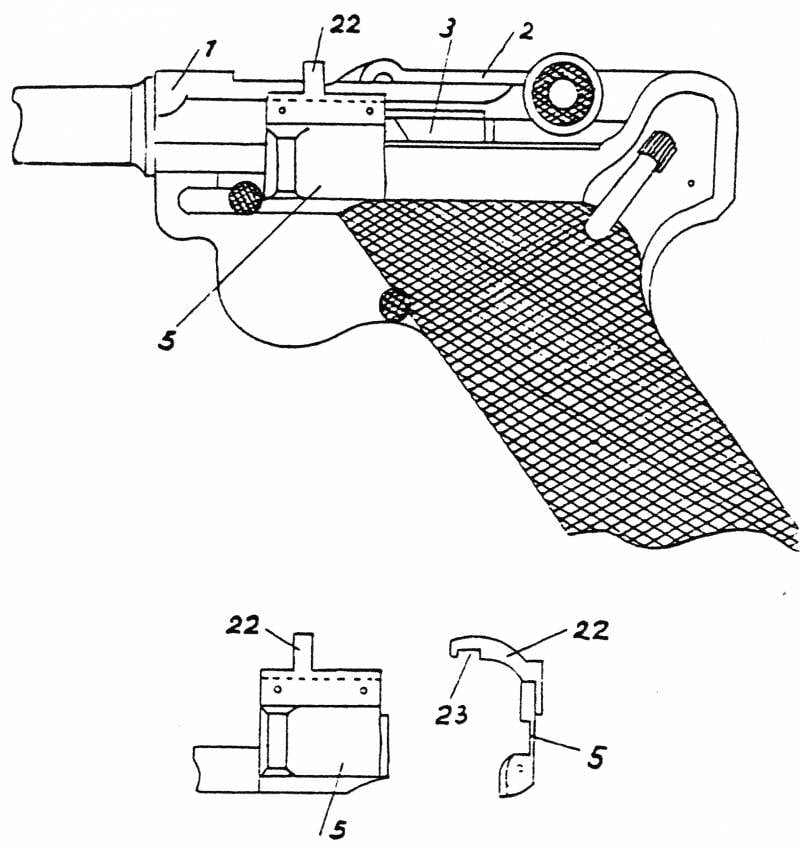
Drawing to patent DRP 566 002 by Alexander Gebauer and Georg Voss. The bar 22 is riveted to the side cover 5. The bar with its U-shaped notch engages with the raised extractor of the loaded pistol, thus preventing the removal of the side cover and access to the sear (Joachim Görtz, Dr. Geoffrey Sturgess "The Borchardt & Luger Automatic Pistols")
The same two inventors were issued a DRGM certificate 1 325 431 dated February 19, 1930, which described two options for altering the sear, which made it possible to automatically block it when the side cover was removed. In addition, Gebauer and Foss registered several additional designs in 1930–1945, but little of these developments have survived.
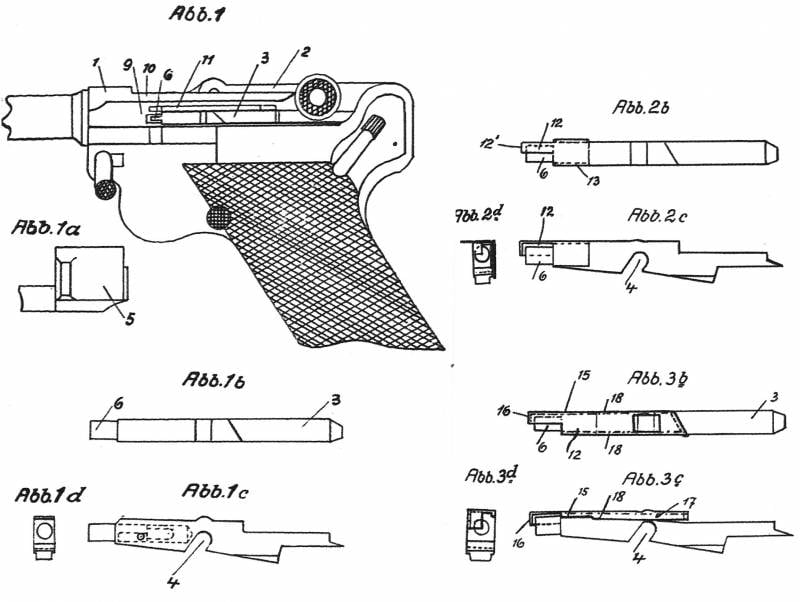
Drawing for certificate DRGM 1 325 431 by Alexander Gebauer and Georg Voss. Two versions of the sear guard (Abb 2 and Abb 3), which blocks it when the pistol is disassembled (Joachim Görtz, Dr. Geoffrey Sturgess, The Borchardt & Luger Automatic Pistols ")
Competitors. And again Ludwig Shivi
In a tender announced by the Prussian police, Ludwig Shivi proposed, in addition to the sear fuse, a store fuse, for which he received patent DRP 587 781 dated February 10, 1932.
It was a three-arm lever located in a vertical groove in the frame between the magazine and the trigger guard. The lever swung on an axis mounted between the magazine release button and the back of the trigger guard. The magazine inserted into the handle pressed forward on the upper arm of the lever, turning it forward and thus disengaging the tip of the lower arm from the bent rear part of the trigger, thereby freeing it for firing.
When the magazine was removed, the lever returned to its original position, and the lower shoulder blocked the trigger. The rear shoulder rested against a coil spring located under the magazine latch. This spring, in fact, set the structure in action.
The amount of precision machining required for the manufacture of such a device was much less than that required for the manufacture of Walter's spring safety device adopted by the police. But with the installation it was the other way around - a careful and precise manual adjustment was required. Which, compared to the simple setup of the competitor, was a clear loss.
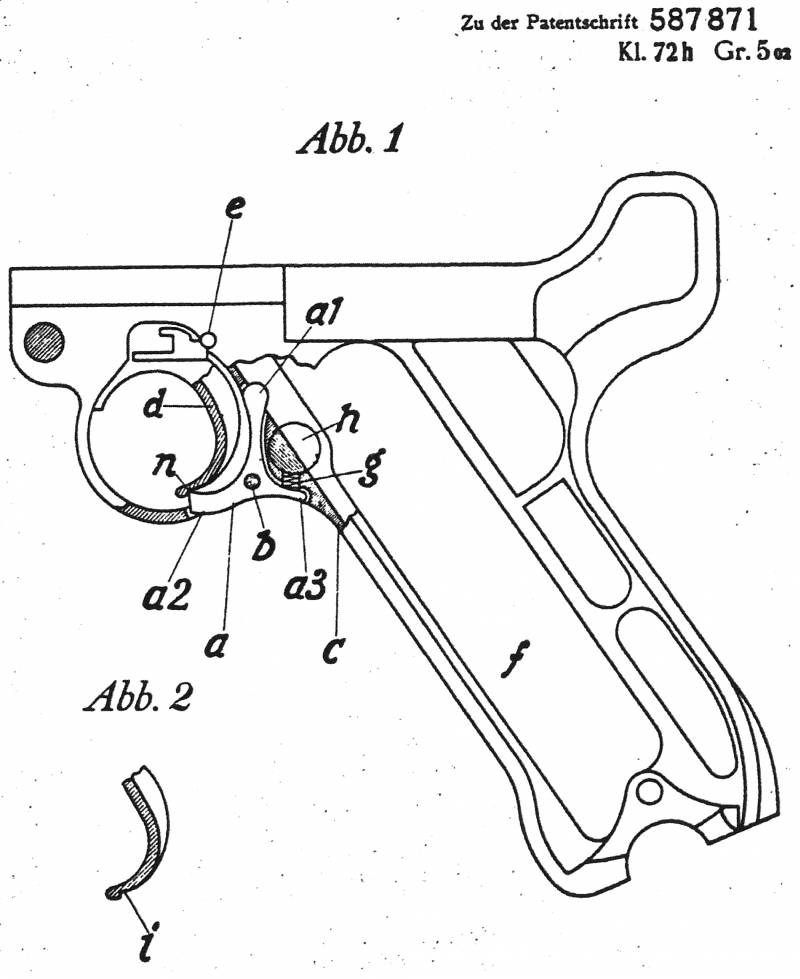
Drawing for patent DRP 587 781 by Ludwig Shivi on "Safety device for self-loading weapons" (Joachim Görtz, Dr. Geoffrey Sturgess "The Borchardt & Luger Automatic Pistols")
Competitors. Carl Walther's first attempt
The first attempt by the Carl Walter company to create an in-store fuse was unsuccessful. Although this development was granted a patent DRP 593 956 dated March 17, 1932.
The design turned out to be rather difficult to install. It was a latch with a hook, spring-loaded at the back and sliding in a groove that needed to be cut in the frame above the axis of the trigger. Its rear end interacted with the front wall of the store. When the magazine was inserted, the latch moved forward. At the same time, the hook in its lower part disengaged from the trigger and released it, making it possible to fire.
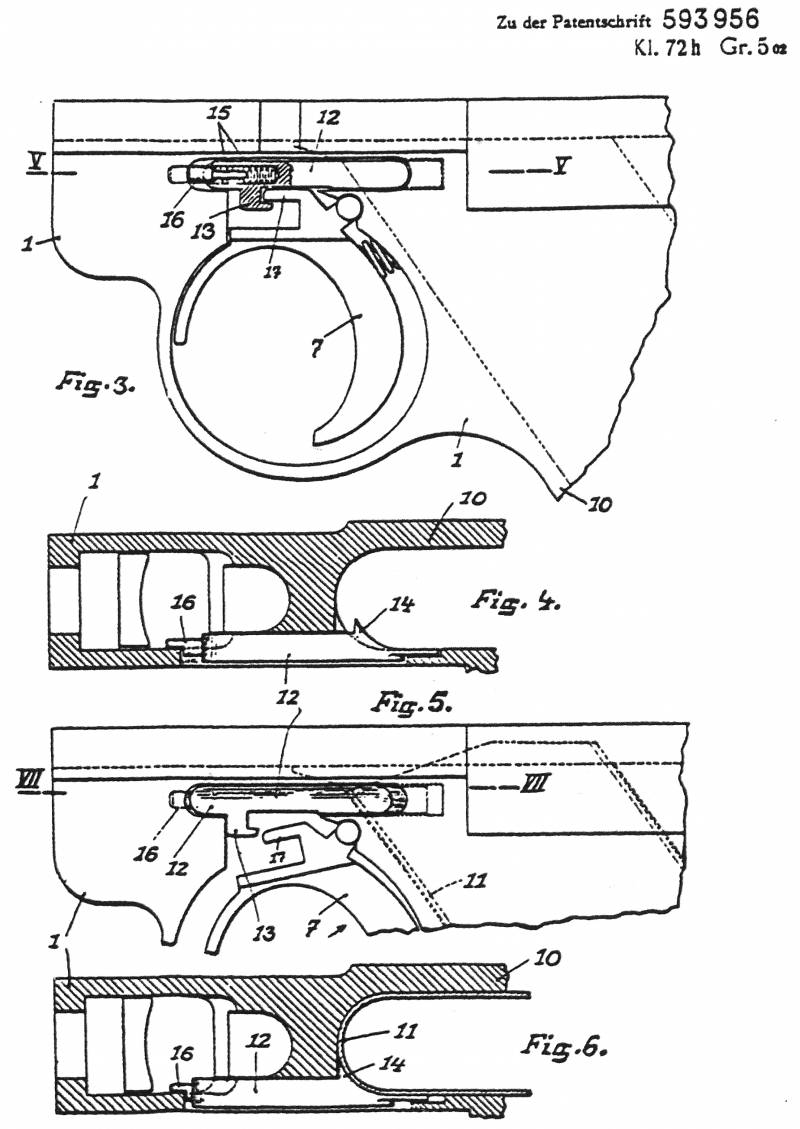
Drawing from DRP 593 956 for "Safety Device" issued to Karl Walter. This was her first attempt at a magazine-type safety device (Joachim Görtz, Dr. Geoffrey Sturgess "The Borchardt & Luger Automatic Pistols")
Precise machining was required both for the production of device parts and for the modification of the pistol itself for the installation of a safety device. It was objectively more expensive than the bent spring steel fuse, which was later developed by Friedrich Walter and, after winning the tender, was put into production.
Competitors. Ideas from Simson & Co
The company "Simson" also proposed its design of fuses.
Three German registered design certificates DRGM 1 232 662 of 12 July, DRGM 1 232 664 of 15 July and DRGM 1 234 199 of 27 August 1932 respectively protected the design of two sear fuses and one magazine fuse.
One sear fuse was offered in two versions and was a leaf spring or, alternatively, an articulated arm mounted on the sear that would lift up and lock when the side cover was removed. When installing the cover, it fit under it and did not interfere with the movement of the sear.
The second one was a complex spring latch installed in a hole in the sear and located vertically. When removing the side cover, the sear was locked in the receiver with a pin.
Although the first fuse was very similar in concept to the Shivi fuse, it was more difficult to install. The leaf spring was inserted into a dovetail groove milled in the sear, and the sear itself was machined to match its thickness along the top. The design was fragile and unreliable.
The magazine fuse was a spring-loaded cam mounted across the frame immediately behind the trigger, with a protrusion to block the movement of the trigger, which, when the magazine was inserted, moved to the side with its front part, releasing the trigger.
The in-store fuse used a similar concept to the Walter's fuse. But, unlike a simpler and more successful competitor, which was a single springy part, it consisted of several parts. In addition, more complex machining was required to install it.
Unfortunately, not a single sample of Simson fuses has survived to this day.
Competitors. Attempt by ERMA
Erma (ERMA) filed a patent application DRGM 1 232 062 on July 19, 1932 for a "Self-adjusting sear lock for pistols," in which a thin leaf spring was fixed under the front of the sear. When the side cover was removed, it entered a special groove milled in the receiver body, blocking the sear movement. When installing the side cover, the bottom edge pushed the plate upward, freeing the sear. Both the fragility of the spring, its tiny retaining screw, and the fine workmanship required for installation testified against this design.
The development of the Erma company suffered the same fate as the Simson fuses - not a single sample survived.
Competitors. Exotic by JP Sauer & Sohn
The last group of devices for which patents of registered design were issued in this mad race of ingenuity were: "Fuse sear for automatic pistol" DRGM 1 234 080 from November 15, 1932, "Trigger mechanism for automatic pistol" DRGM 1 256 201 from 15 November 1932 and "Displaced Spring Loaded Sliding Arms in an Automatic Pistol" DRGM 1 243 082 dated November 17, 1932. JP Sauer & Sohn from Suhl became the copyright holder of all of them.
All three of these designs were merged into one in Patent Application No. 944 887, dated November 29, 1932, but this was not accepted or satisfied.
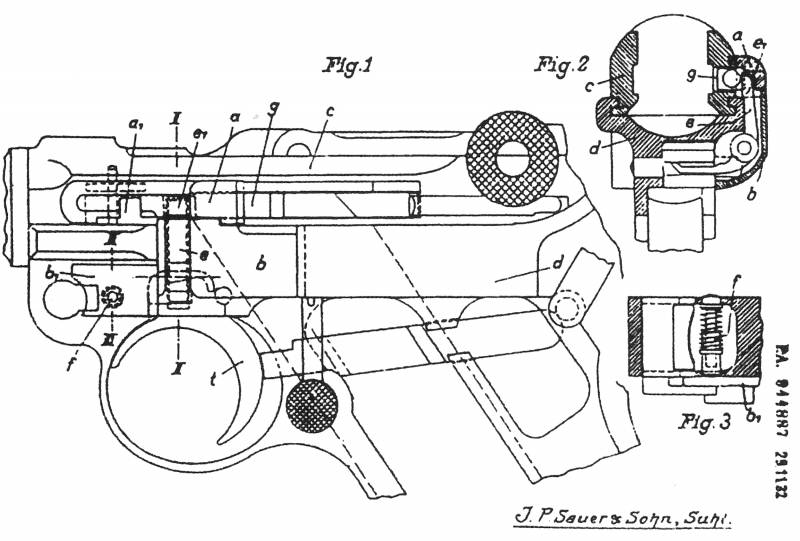
Drawing from Sauer patent application PA 944 887. The sear is closed by a casing of a complex configuration. A spring loaded plunger is positioned in the gun frame parallel to the disassembly lever securing the side cover. Serves to remove it when disassembling weapons (Joachim Görtz, Dr. Geoffrey Sturgess "The Borchardt & Luger Automatic Pistols")
There are only two copies of the Luger pistol equipped with a sear fuse of the first design (DRGM 1 234 080).
One of them may have been a model for a patent. This design consisted of a side cover with the upper part cut off to half, which made it possible to see the transmission lever of the trigger, covered from above with a casing attached to the receiver with a pin.
In order to disassemble the pistol, a vertical slot was made on the side surface of the casing, through which the end of the transmission arm was supposed to pass. But due to the small size of the cut-off side cover, which also fit snugly against the casing, it was impossible to grasp it with your fingers during disassembly.
For the sake of fairness, it should be noted that even a tight-fitting full-size, not cut off cover is sometimes impossible to remove just like that without something not to pick it up.
For this, a spring-loaded plunger was provided, which passed through the front part of the frame protrusion, directly above the trigger and behind the pistol disassembly lever (or, as indicated in the NSD, published in the USSR, the barrel delay). With its left end, the plunger rested against the retaining protrusion of the side cover, pushing it outward, thereby making it possible to remove it when the disassembly lever is turned down, and the vertical shoulder of the transmission lever was exactly opposite the casing slot.
On the upper part of the pistol removed from the frame (receiver with barrel and bolt group assembled), the casing always remained on the receiver, rigidly fixed with a pin, thereby preventing accidental access to the front of the sear, as an object of increased danger. It was just a casing, but a very complex configuration.
One surviving example of this extraordinary and complex modification is the 1906 Parabellum, the so-called New Model of 7,65 mm caliber and 120 mm barrel length, serial no. 67098. Obviously, it was a prototype, with neatly outlined casing contours. copying the top of the standard side cover.
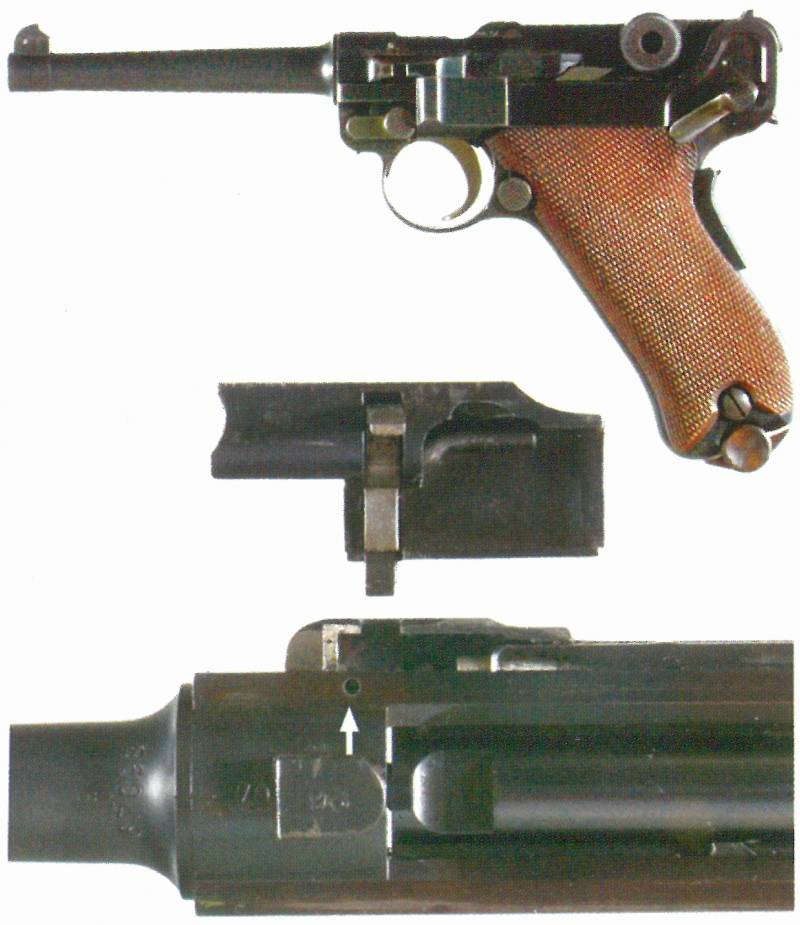
"Parabellum" model 1906 - the surviving prototype of JP Sauer & Sohn, equipped with a sear fuse. The casing covering the sear is pinned to the receiver (hole in the direction of the arrow) (Joachim Görtz, Dr. Geoffrey Sturgess "The Borchardt & Luger Automatic Pistols")
In the process of disassembling the pistol, the casing was pulled back together with the receiver until the protruding upper end of the trigger lever coincided with the vertical slot in the casing in order to freely pass through it when the side cover was removed.
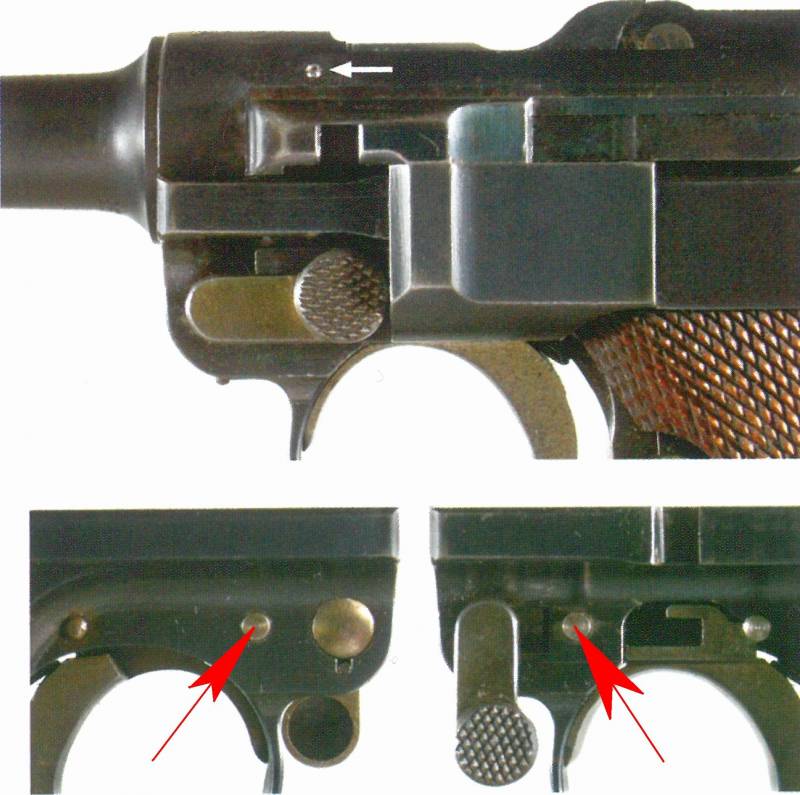
A captive spring loaded plunger (red arrow) is located next to the gun disassembly lever. It is necessary to break off the tightly pressed side cover when disassembling the weapon (Joachim Görtz, Dr. Geoffrey Sturgess "The Borchardt & Luger Automatic Pistols")
Another very unusual prototype of 9 mm caliber, manufactured by Simson, could also be a patent model.
The date was missing on the receiver; the connecting rod was marked with Simpson & Co. Most likely, it was made for Sauer on the basis of a new pistol, since it had a unique serial number "a" with the typical "Simson" typeface printed on the front on the frame under the barrel, and the usual abundance for the firm of the hallmarks of inspection acceptance " eagle / 6 ", but in non-standard places.
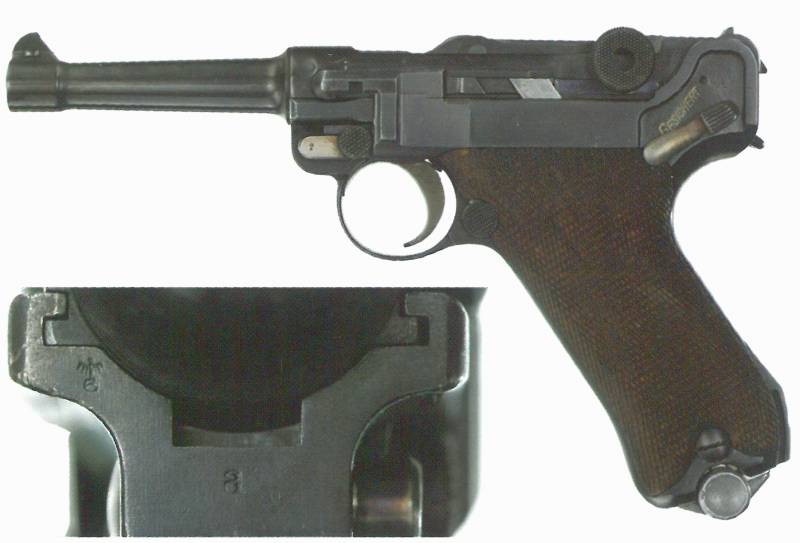
The prototype P.08 with the installed fuse searched for the Sauer design. Made by special order by Simson, it has an unusual serial number "a", printed only on the front of the pistol frame. Nearby there is an inspection mark "eagle / 6", which is very unusual for the location of such brands (Joachim Görtz, Dr. Geoffrey Sturgess "The Borchardt & Luger Automatic Pistols")
The connection between the upper edge of the trimmed side cover and the lower edge of the casing was for unknown reasons made in a step. And the spring-loaded plunger protruded from the frame on the right, which made it possible, if necessary, to manually press on it during disassembly. Because the force of the plunger spring might not have been enough to move the side cover from its place.
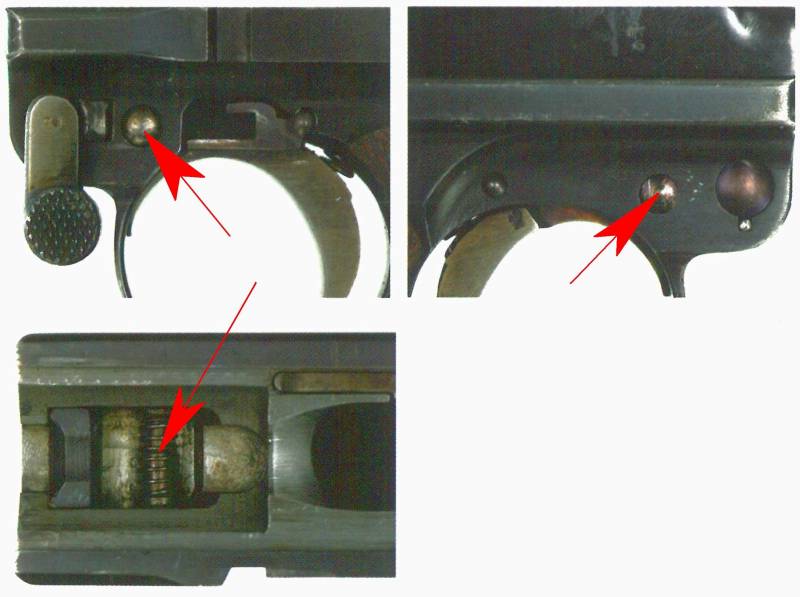
Spring-loaded plunger (in the direction of the arrow) for breaking off the cut-off side cover (author's photo collage)
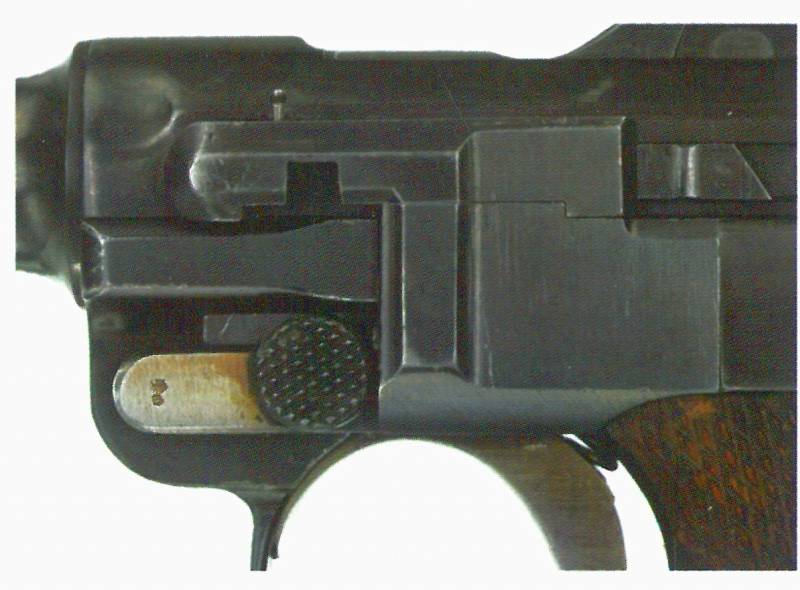
Step connection between side cover and shroud (Joachim Görtz, Dr. Geoffrey Sturgess "The Borchardt & Luger Automatic Pistols")
Mechanically, this pistol was identical to the prototype based on the "New Model".
To disassemble the weapon, it is necessary to pull the bolt back completely before setting it to the bolt delay (the magazine must be deliberately without cartridges). Then turn the disassembly lever down. In this case, the side cover released from the holding is squeezed out by the spring-loaded plunger. The transfer lever in this position is opposite the groove in the sear's protective casing, which allows you to remove the side cover and continue disassembling the pistol in the usual manner.
Since the shutter is held by a slide delay, activated by an empty magazine, in this case it is completely impossible to load the cartridge into the barrel. And in the removed receiver there is guaranteed to be no cartridge. Of course, unless you deliberately charge it, which makes the original purpose of protecting the sear with a casing functionally simply superfluous.
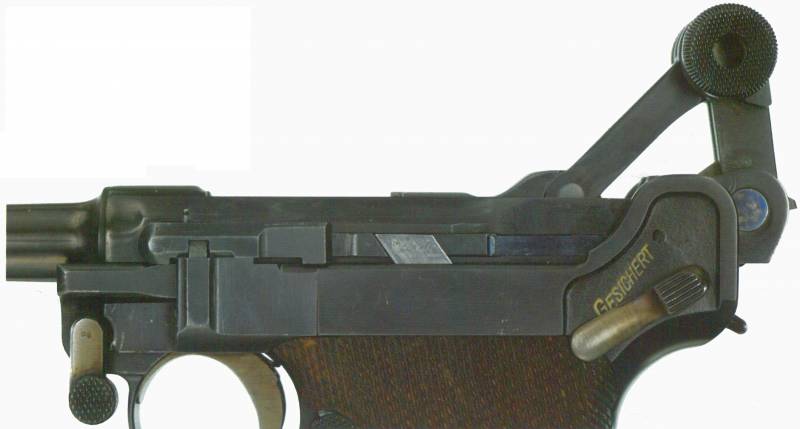
Disassembly position: the bolt is fully pulled back and held in the open position by the slide stop, and the disassembly lever is turned down (Joachim Görtz, Dr. Geoffrey Sturgess "The Borchardt & Luger Automatic Pistols")
The complexity and high cost of manufacturing components, as well as the need for additional machining during installation in each case, made this design unpromising for use. In addition, the use of the device only as a protection for the sear against accidental pressing was inadequate, since, unlike the Shivi fuse, it did not block it reliably in order to exclude any possibility of firing a shot. So to speak, "the game was not worth the candle."
The figure for patent application PA 944 887 also shows a simple magazine fuse with a registered design DRGM 1 256 201. It was a bar running in guides cut in the frame under the left cheek. The magazine inserted into the handle pressed with its rear part on the cam of the strap, displacing it back, while the front protrusion freed the trigger from blocking.
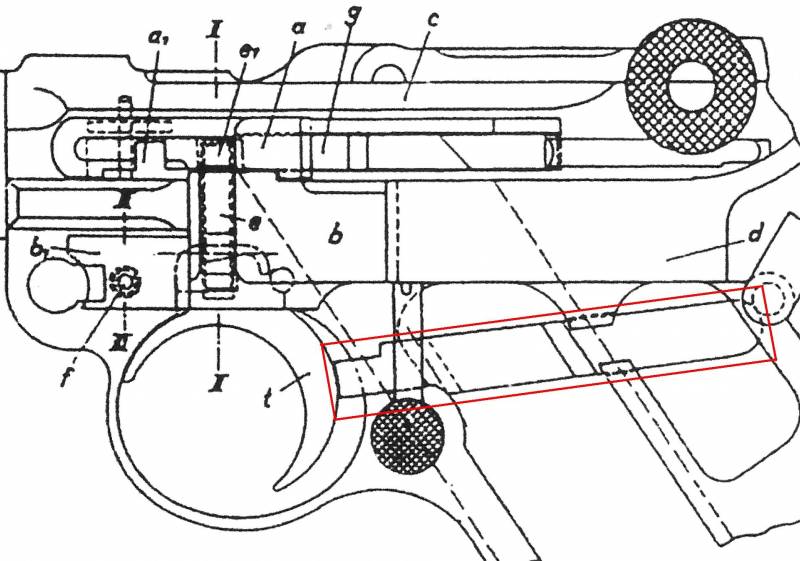
Magazine fuse (highlighted in red) from JP Sauer & Sohn from patent application PA 944 887 (Joachim Görtz, Dr. Geoffrey Sturgess "The Borchardt & Luger Automatic Pistols")
The design of the device was very simple. However, such a magazine fuse was never used in any of the existing P.08. He remained one of the applicants who ended up overboard in the tender.
Race participants
In the tender for equipping the R.08 with additional fuses, announced by the Prussian police, both previously unknown private individuals and world-famous weapons companies took part. Based on the available materials and information, you can compile a relatively accurate list of participants in this interesting and unusual event in stories parabellum.
German patents (DRP) and registered designs (DRGM) related to
to the additional fuses for the Luger pistol in chronological order.
DRP 501 267 "Automatic safety for small arms whispered" (Selbsttätige Sicherung für die Abzugsstange von Hanfeuerwaffen) announced on 19 July 1929 by Ludwig Schiwy, Berlin, SW 68, Lindenstrasse 90.
DRP 566 002 A "self-loading pistol" (Sebstladepistole) announced on January 8, 1930 by Alexander Gebauer, Berlin-Wilmersdorf, Durlacher Strasse 15, and Georg Voss, Berlin-Lankwitz, Charlottenstrasse 31.
DRGM 1 325 341 The Sebstladepistole was announced on 19 February 1930 by Alexander Gebauer, Berlin-Wilmersdorf, Durlacher Strasse 15, and Georg Voss, Berlin-Lankwitz, Charlottenstrasse 31.
DRGM 1 199 592 Pistolensicherung declared on 5 March 1931 to Carl fon Haryes, Berlin-Charlottenburg, Leistikowstrasse 2.
DRP 587 871 "Safety device for self-loading firearms" (Sicherungseinrichtung für Selbstladewaffen) announced on 10 February by Ludwig Schivi, Berlin, SW 68, Lindenstrasse 90.
DRP 593 956 "Safety device" (Sicherungseinrichtung) declared March 17, 1932 by Carl Walther, Zella-Melis arms factory, Thuringia.
DRGM 1 232 662 "Pistol sear fuse" (Abzugsstollensicherung für Pistolen) announced on 12 July 1932 by Simson & Co, an arms factory in Suhl, Thuringia.
DRGM 1 232 664 "Pistol Trigger Lock" (Abzugssicherung für Pistolen) declared on 15 July 1932 by Simson & Co, Suhl Arms Factory, Thuringia.
DRGM 1 232 062 "Automatic sear safety for pistols" (Selbsttätige Sicherung für Pistolen) announced on 19 July 1932 by Erma (ERMA, Erfurter Maschinen- und Werkzeugfabrik B. Geipel GmBH), Erfurt, Rudolfstrasse.
DRGM 1 228 876 Magazinesicherung an Selbstladepistolen (Magazinesicherung an Selbstladepistolen) announced on July 20, 1932 by Carl Walther, an arms factory in Zella-Melis, Thuringia.
DRGM 1 228 449 "A sear fuse for self-loading pistols of 7,65 and 9 mm caliber" (Abzugsstollensicherung für Selbstladepistolen von 7,65 und 9 mm Kaliber) announced on July 25, 1932 by Emil Schmidt, Hamburg 30, Bismarkstrasse 62.
DRGM 1 234 199 "Pistol sear fuse" (Abzugsstollensicherung für Pistolen) announced on August 27, 1932 by Simson & Co, an arms factory in Suhl, Thuringia.
DRGM 1 237 949 Magazinesicherung an Mechrladewaffen announced on 1 October 1932 by Carl Walther, an arms factory in Zella-Melis, Thuringia.
DRGM 1 234 080 "Fuse sear for automatic pistols" (Abzugsstollensicherung für automatische Pistolen) announced on 15 November 1932 by JP Sauer & Sohn, Suhl, Thuringia.
DRGM 1 256 201 An "automatic pistol trigger" (Auslösemechanismus für automatische Pistolen) announced on 15 November 1932 by JP Sauer & Sohn, Suhl, Thuringia.
DRGM 1 243 082 "Displaced spring-loaded sliding arms in an automatic pistol" (Versetzte federbelastete Gleitarme für automatische Pistolen) announced on November 17, 1932 by JP Sauer & Sohn, Suhl, Thuringia.
The last three DRGM applications from Sauer & Sohn were combined into one patent application RA No. 944 887 dated November 29, 1932, but this was not accepted and was not granted.
Most likely, this is still not a complete list of contenders for victory in the frantic race for the prize of the winner of the tender for the safe parabellum.
This register contains only those about whom reliable information has been preserved for today. There must have been other competitors as well. This piece of cake was too tasty during that difficult and hectic time. But this can only be guessed at.
Conclusion
When looking at the fuse design of competing applicants, it seems that the police leadership quite sensibly chose those that were simpler (and therefore cheaper), easier to install, with simple drilling of holes, which could be done by the staff of local weapons depots without the use of precision machines. That, in fact, was done centrally in order to bring all the P.08 in service to uniformity.
By the way, such a centralized solution to the problem was very typical for the power structures of Germany at that time. In this regard, it is worth recalling how at one time the issue was resolved with the modification of the flag fuse on the P.04, which had just been adopted by the Kaiser fleet.
The fact is that on "sailors" released before 1910, the flag had to be turned up to put the weapon on the safety catch. There have been cases when, when inserting the 04th into the holster, he clung to its edge and shifted down to the position for firing. Which led to cases of unintentional shooting when removing the pistol from the holster.
Then in one fell swoop, by order of the command, all P.04 were removed from the naval crews and transferred to the ship repair shops for alteration. In this case, the inscription Gesichert (safe) was simply cut off with a cutter, and a new one was applied above.
And since 1910, the marine luger began to be produced with a changed position of the safety catch - "safe" in the lower position. Moreover, this version of it became in the future mandatory for all other modifications of parabellums.
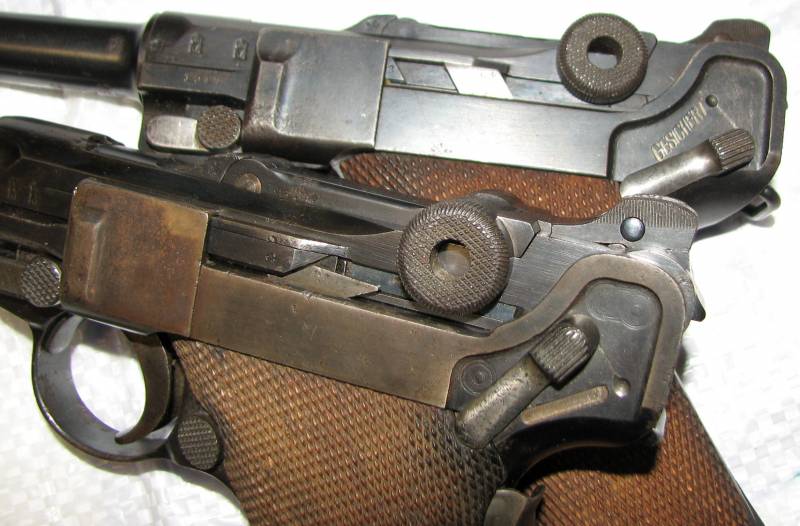
P.04 of the 1906 model of the first production series with a reworked fuse - you can see a trace of the cut off Gesichert inscription (below) and P.04 of the 1914 model already with a new fuse (above) (author's photo)
Extensive tests confirmed the functionality of the Shivi fuse and Walter's magazine fuse, and on August 30, 1933, they were accepted by the Prussian police to equip the P.08 pistols.
However, even before the nationalization of state forces, the need for such modernization was questioned. For example, an article published in the Journal of Laws of the Prussian Ministry of the Interior (Ministerialblatt des Rechs - und Preussischben Ministeriums des Innert) on June 24, 1936, requested information on their effectiveness.
As the saying goes, there is no smoke without fire.
These doubts were not groundless, which was later confirmed.
The experience of operating the R.08 with "double insurance" in the Reich police showed that the magazine fuse was superfluous. Its effectiveness looked questionable - the presence of such a device for especially "gifted" craftsmen never stopped from rash actions. Actually, another confirmation of this is that this type of fuse in pistols was used and is used extremely rarely.
For example, if the Browning FN HP model of 1935 had a store fuse, then the post-war versions of the “high power” did not have it. I must say, and now in the overwhelming majority of models it is not used.
Ludwig Shivi's whisper fuse “lived” a little longer than the store one. But, in the end, they abandoned him too.
One of the reasons, perhaps, was still an imperfect design. The rivet that fixed the spring plate on the sear was extremely small. Its "cap" over time was deformed, pressed up by the plate, and could no longer provide a rigid fixation of the sear. The fuse simply "dangled" freely on the rivet and did not perform its functions. Moreover, it became deadly, instilling false confidence in the safety of disassembling a parabellum with a cartridge in the barrel.
P.08 continued to serve in the police after World War II, both in East and West Germany. And no one, both in the west and in the east, has ever been puzzled by equipping these pistols with any additional safety devices.
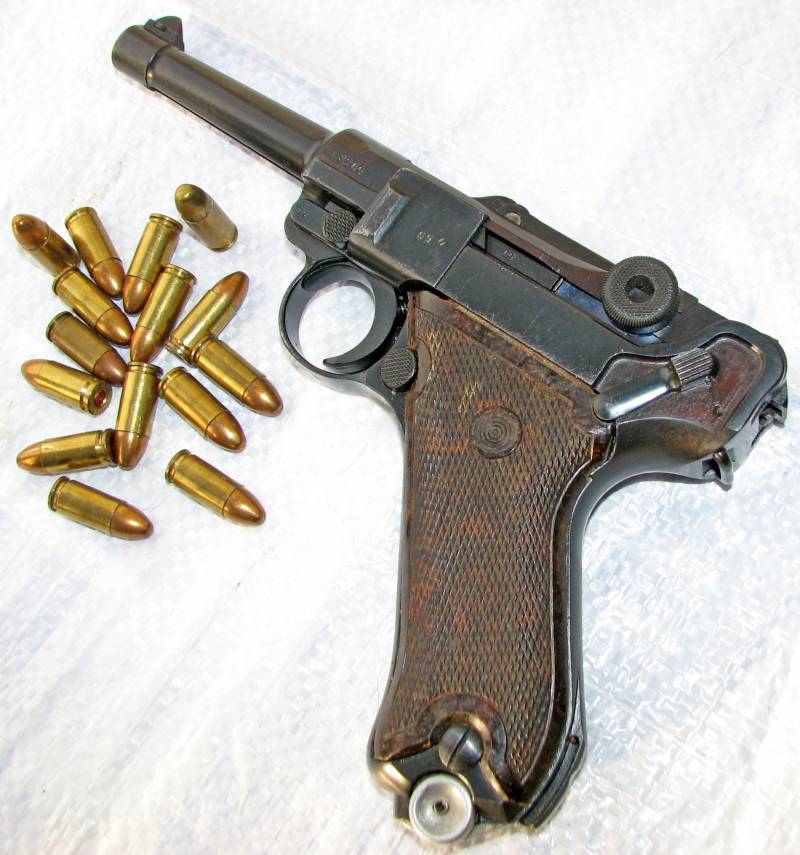
R.08 was in service with the People's Police of the GDR (VoPo - Volks Polizei). Standard parabellum with characteristic brown-mottled plastic cheeks (author's photo)
It should be noted that ordinary parabellums were also in the service of the Reich police, for some reason they did not receive additional fuses. And they can be identified as "policemen" only by the presence of special markings used before the First World War and during the Weimar Republic. And the weapons adopted by the police after the elimination of the autonomy of the Land Police - under the hallmarks of police inspector acceptance.
But this is a topic for another conversation.
Продолжение следует ...
Information